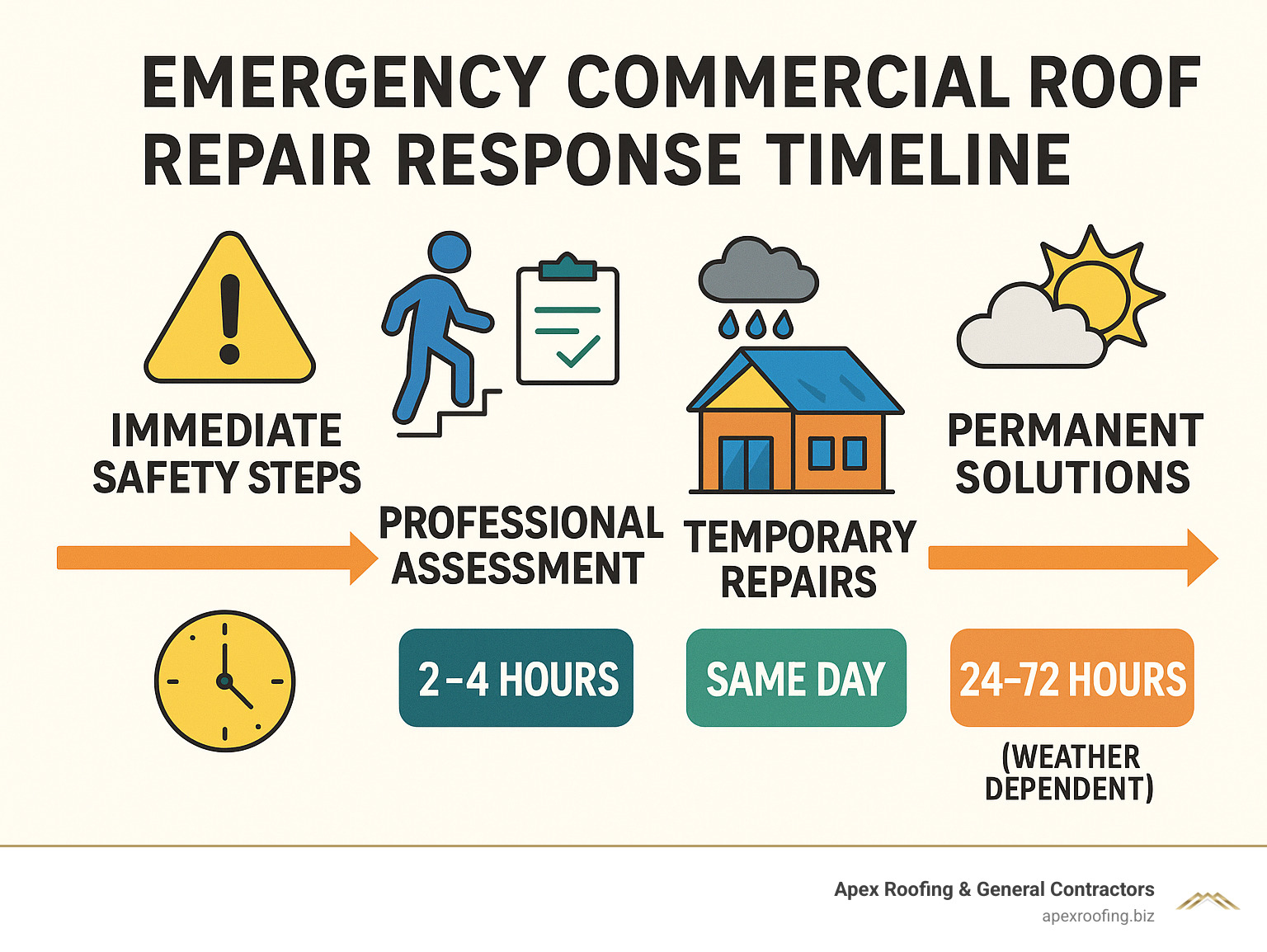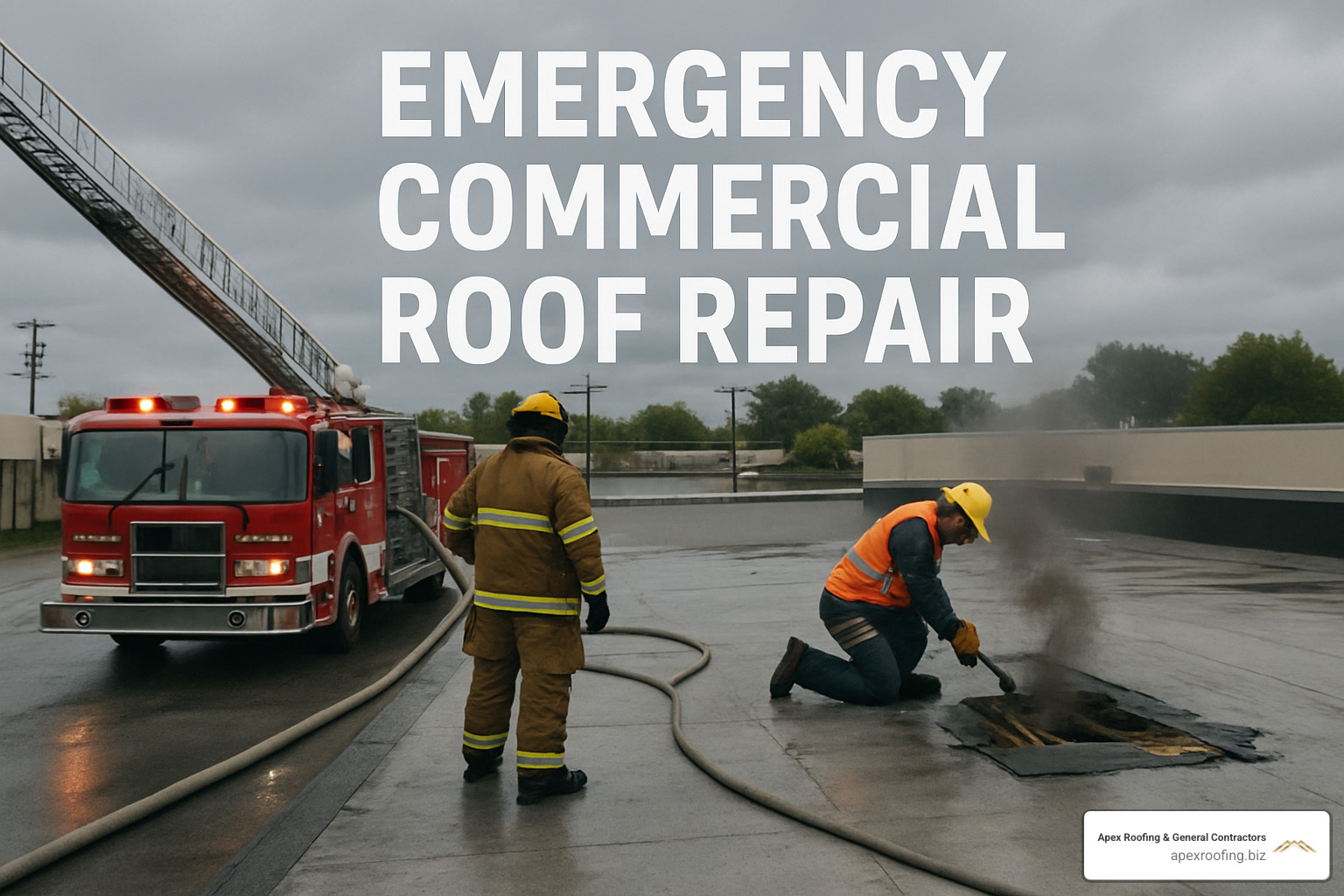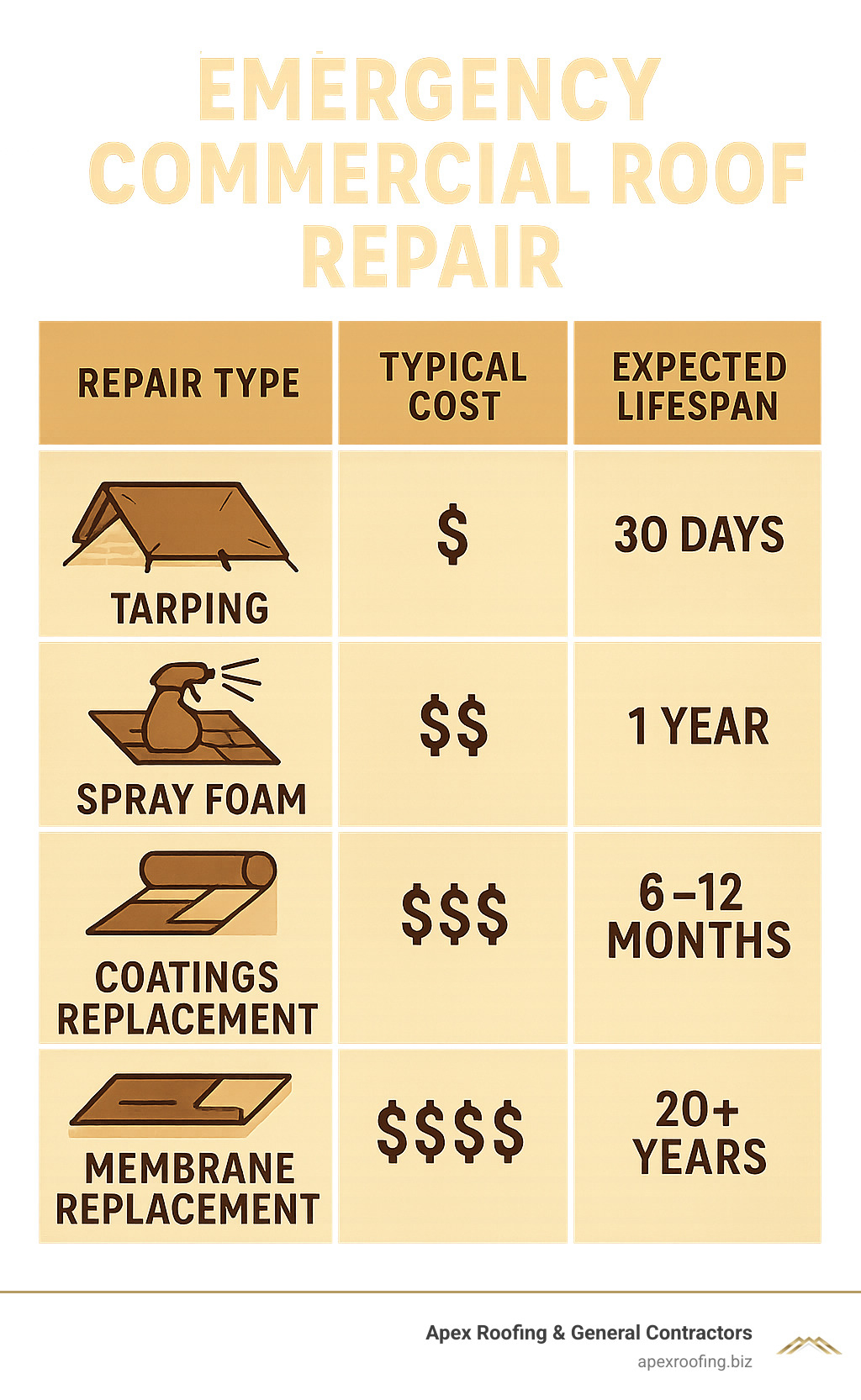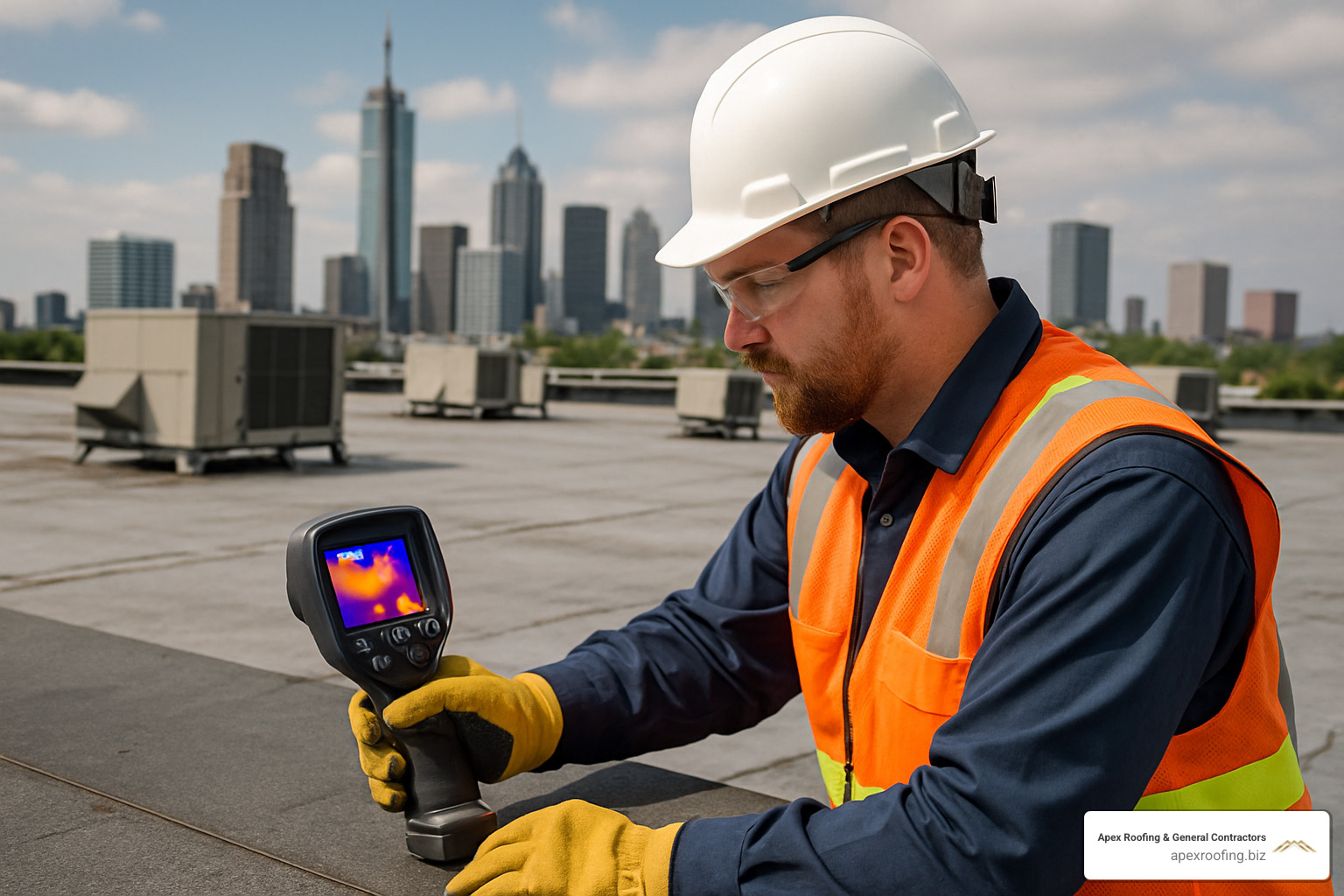When Your Commercial Roof Fails: The Critical First Hour
Emergency commercial roof repair becomes your top priority when storm damage, sudden leaks, or structural failures threaten your business operations. Here’s what you need to know immediately:
Immediate Action Steps:
- Safety first – evacuate affected areas and shut off electricity if water is present
- Document damage – take photos for insurance claims before moving anything
- Call professionals – contact a 24/7 emergency roofing service within the first hour
- Minimize damage – move equipment and inventory away from leak areas
- Temporary containment – use tarps or buckets until help arrives
Common Commercial Roof Emergencies:
- Storm damage from hail, wind, or debris
- Sudden membrane failures causing interior flooding
- Clogged drains leading to ponding water
- Equipment damage from roof penetrations
- Structural sagging from snow or ice loads
When disaster strikes your commercial property, every minute counts. Research shows that immediate emergency roof repair can minimize company downtime, reduce disaster restoration needs, and save thousands in secondary damage costs. A failed roof doesn’t just let water in – it can shut down operations, damage expensive equipment, and put employees at risk.
The difference between a minor repair and a major reconstruction often comes down to how quickly you respond. Professional emergency crews can typically arrive within 2-4 hours, but knowing what to do in that critical first hour can make all the difference for your business.
I’m Carlos Yzaguirre, President of Apex Roofing & General Contractors, and I’ve helped countless San Antonio businesses steer emergency commercial roof repair situations since 2022. Through our 24/7 response service, we’ve seen how proper emergency protocols can save businesses from weeks of costly downtime and extensive interior damage.

Recognizing & Responding to Commercial Roof Emergencies
When your commercial roof starts showing signs of distress, knowing the difference between “fix it next week” and “call for help right now” can save your business from disaster. After years of responding to emergency commercial roof repair calls throughout San Antonio and the Hill Country, I’ve learned that certain warning signs demand immediate action.
What Makes a Roof Emergency Critical
Debris impacts from fallen trees or construction materials don’t just create holes – they create gateways for thousands of gallons of water to pour into your building. We once responded to a call where a single tree branch punched through a restaurant’s roof membrane. The owner thought it could wait until morning. By dawn, water had destroyed $50,000 worth of kitchen equipment and forced a three-week closure.
Hail punctures might look small from the ground, but they’re like tiny time bombs. San Antonio’s notorious hailstorms can pepper a roof with dozens of punctures, each one allowing water to seep into insulation layers. What starts as a few drops becomes a flood during the next heavy rain.
Wind lift-offs are exactly what they sound like – and they’re terrifying to witness. High winds can peel back entire sections of membrane roofing like opening a can of sardines. Your building’s interior becomes completely exposed to the elements, and there’s no “waiting until business hours” when this happens.
When you spot interior leaks, especially near electrical equipment or HVAC systems, you’re looking at an immediate safety hazard. Water and electricity make dangerous partners, and we’ve seen businesses forced to evacuate entire floors when leaks threatened electrical systems.
Clogged drains might seem minor, but they create water ponding that can literally collapse your roof. We’ve measured ponding water six inches deep on flat roofs – that’s thousands of pounds of extra weight your structure wasn’t designed to handle.
Failed seals around roof penetrations like HVAC units, exhaust vents, or skylights create leak highways that funnel water directly into your building’s most sensitive areas. These failures often happen suddenly and worsen rapidly during rain events.
Structural sagging is your roof’s way of waving a white flag. If you can see visible sagging or movement, evacuate the area immediately and call for emergency help. This isn’t a repair issue – it’s a safety crisis.

Why Every Hour Counts
Here’s the brutal truth about delaying emergency commercial roof repair: water doesn’t stay put. It travels through your building like an unwelcome explorer, finding every crack, crevice, and system to infiltrate. We’ve documented cases where a small membrane failure snowballed into complete electrical system replacement, extensive mold remediation, and inventory losses exceeding $100,000.
The scariest part? Business interruption. We’ve seen companies forced to close for weeks while repairs were completed, losing not just repair costs but revenue, customer trust, and employee wages. One delayed response to a weekend leak cost a local manufacturer three weeks of production time.
When weather alerts hit Bexar County, smart business owners prepare. Having emergency supplies positioned and our contact information handy can make the difference between a quick fix and a major disaster.
More info about storm damage repairs
Emergency Commercial Roof Repair Checklist
When disaster strikes your roof, panic is your worst enemy. We’ve developed this systematic approach after responding to hundreds of emergency calls throughout San Antonio and surrounding communities.
Your first fifteen minutes are crucial. Start with leak isolation – figure out where the water is coming from and how far it’s spreading. Next, shut down sensitive equipment in affected areas. Water and electricity don’t mix, and we’ve seen minor leaks become major safety hazards when electrical systems stay energized.
Move inventory away from leak zones immediately. Documents, electronics, and sensitive materials can be destroyed in minutes once water starts flowing. While you’re protecting your assets, take photos from multiple angles – your insurance company will need this documentation later.
Call our 24/7 hotline at (726) 727-7663 as soon as you’ve secured immediate safety. The sooner we know about your emergency, the faster we can mobilize our crew. Finally, deploy temporary containment measures like tarps, buckets, or plastic sheeting to minimize water damage until help arrives.
Remember these safety basics: never enter areas with standing water near electrical equipment, avoid walking on wet or damaged roof surfaces, and keep everyone away from affected areas. Post warning signs if necessary and have emergency lighting ready if power needs to be shut off.
When to Call for Emergency Commercial Roof Repair
Not every roof problem requires a middle-of-the-night emergency call, but certain situations absolutely do. After storms with hail larger than a quarter, winds exceeding 60 mph, or heavy rain causing visible leaks, don’t wait to assess damage. Weather-related damage typically worsens rapidly.
Sudden leaks during business hours create immediate operational disruptions. We prioritize these calls because we understand that every minute of downtime costs money. Blow-offs where wind has lifted membrane sections require immediate response – your building interior is completely exposed to the elements.
Compromised flashing around roof edges, penetrations, or joints can fail suddenly and catastrophically. These failures often happen without warning and create multiple leak points simultaneously.
Multi-family complexes face unique challenges during roofing emergencies. Tenant safety, displaced residents, and multiple unit impacts require specialized response protocols. Our team has extensive experience managing these complex situations throughout Bexar County, ensuring both immediate safety and long-term resident satisfaction.
More info about apartment & multi-family roofs
Emergency Commercial Roof Repair Options & Lifespans
When your commercial roof fails, understanding your repair options helps you make smart decisions during what’s often a stressful situation. Each emergency commercial roof repair method has specific applications, costs, and expected lifespans that affect both your immediate response and long-term planning.

Emergency tarping provides immediate weather protection for large damaged areas and remains our most common first response. Professional installation includes proper anchoring and wind resistance – something you definitely don’t want to attempt yourself during a storm. Quality tarps typically last 30-90 days depending on weather conditions, making them cost-effective for extensive damage that requires time to plan complex permanent repairs.
Spray foam patches work exceptionally well for irregular holes and cracks. The polyurethane foam expands to seal gaps that traditional patches can’t handle effectively. Application requires dry conditions and temperatures above 50°F, but once applied, the foam becomes tack-free in 20-30 seconds and walkable in just 2-3 minutes. Properly applied foam patches can last up to one year, making them excellent bridge solutions while you plan permanent repairs.
Elastomeric coatings create seamless, waterproof barriers over existing surfaces. These liquid-applied coatings work on various substrates including metal, TPO, and EPDM systems. While they require 24-48 hours for full cure, they provide excellent temporary protection for 6-12 months. We often recommend these for larger areas where multiple small failures have occurred.
Wet-applied mastics deserve special mention because they’re designed for active leak situations. These specialized sealants can stop water intrusion immediately, even bonding to wet surfaces and curing underwater. They’re lifesavers when you have ongoing rain and can’t wait for dry conditions.
Sheet-metal flashing provides more durable temporary repairs for punctures and tears. We custom-fabricate metal patches on-site and install them with compatible sealants. Properly installed metal patches function effectively for several months while permanent solutions are planned and scheduled.
Our emergency response typically achieves 2-4 hour arrival times throughout San Antonio, Helotes, Leon Valley, Alamo Heights, Fair Oaks Ranch, Shavano Park, Terrell Hills, and Bexar County. Response times may extend during severe weather when multiple emergencies occur simultaneously – Mother Nature doesn’t spread out her damage conveniently.
Crew safety protocols remain non-negotiable, even during emergencies. Our teams use full fall protection equipment for all roof work and follow OSHA-compliant safety procedures. We continuously monitor weather conditions for safe working conditions and maintain proper lighting for night emergency work. Hazard identification and mitigation happen before any repair work begins.
Permanent solutions like membrane replacement provide long-term answers to emergency situations. Complete or partial membrane replacement can often incorporate improvements over the original system. Single-ply systems like TPO and EPDM can frequently be installed over existing damaged areas, while built-up roofing systems may require complete tear-off and reconstruction.

All emergency repairs must meet local building codes and manufacturer specifications. We maintain professional licensing and stay current with industry best practices through organizations like the National Roofing Contractors Association. Emergency situations don’t excuse cutting corners on quality or safety standards.
Latest guidelines on commercial roof safety
Documentation, Insurance & Damage-Prevention Strategy
When your commercial roof fails, having the right documentation can save you thousands of dollars in insurance claims. I’ve watched too many San Antonio business owners struggle with claim denials simply because they didn’t know what to photograph or how to present their case to adjusters.
Getting Your Insurance Claim Right
The moment you find roof damage, grab your phone and start taking pictures – but don’t move anything yet. Insurance adjusters need to see exactly what happened before any cleanup begins. Take wide shots showing the overall damage, then get close-ups of specific problems like punctured membranes, water stains, or damaged equipment.
Photograph from both inside and outside your building. Show how water traveled through your roof system, where it pooled, and what inventory or equipment got affected. Include something for scale – a coin, ruler, or even your hand works. Most phones automatically timestamp photos, which helps establish when damage occurred.
Keep documenting throughout the emergency response process. Take pictures of temporary repairs, mitigation efforts, and any additional damage you find during cleanup. This ongoing documentation shows you acted responsibly to minimize losses.
Advanced Documentation That Makes a Difference
Moisture scans using infrared technology reveal hidden water damage that regular photos can’t capture. These scans show moisture trapped in walls, ceilings, and insulation systems – damage that might not become visible for weeks. When we perform these scans for clients, insurance adjusters take notice because the technology provides objective proof of water intrusion extent.
Our written inspection reports document everything: what caused the damage, which building systems got affected, and what repairs we recommend. Professional reports carry serious weight with insurance companies and help speed up claim processing.
Having us participate in adjuster meetings often makes the difference between partial and full claim approval. We provide technical expertise that helps adjusters understand complex roofing systems and ensures they don’t miss hidden damage.

Keeping Your Business Running During Repairs
Smart business owners plan for roof emergencies before they happen. Identify your most critical operations and figure out how to protect them. Where can employees work if your main space becomes unusable? What equipment absolutely must stay dry? Can some staff work remotely during repairs?
Our priority response program gives enrolled commercial clients guaranteed service levels during emergencies. When severe weather hits San Antonio and every business needs help at once, program members get faster response times and preferential scheduling. It’s like having a reservation at a busy restaurant – you skip the wait when you need help most.
Think about temporary workspace solutions ahead of time. We’ve helped clients set up temporary offices in undamaged areas, coordinate with nearby businesses for backup space, and plan equipment moves that keep operations running during major repairs.
Preventing Tomorrow’s Emergencies Today
Annual roof inspections catch problems while they’re still small and affordable to fix. Our comprehensive yearly inspections identify potential failure points before they become emergency commercial roof repair situations. We prioritize repairs by urgency and budget impact, so you can plan maintenance spending instead of facing surprise emergency costs.
Keep detailed leak logs of every roof issue, repair, and maintenance activity. This documentation helps identify patterns – maybe your southeast corner always has problems after heavy rain, or certain roof drains clog every fall. These patterns help us plan better solutions and support warranty claims when needed.
The commercial roofing industry spends $15 billion annually nationwide, with much of this cost coming from emergency repairs that proper maintenance could have prevented. Our experience shows that businesses investing in preventive maintenance reduce emergency repair costs by 60-80%.
Regular maintenance programs extend roof life and reduce emergency situations dramatically. Scheduled inspections, drain cleaning, and minor repairs prevent small issues from becoming major problems. It’s much cheaper to replace a few feet of flashing than to deal with water damage throughout your building.
More info about commercial roofs
Frequently Asked Questions
What qualifies as an emergency commercial roof repair?
When your roof starts leaking during business hours or you find storm damage that threatens your property, you’re probably wondering if this counts as a true emergency. The answer depends on whether the situation poses immediate risks to safety, property, or your ability to operate.
Storm damage from hail, wind, or debris creates genuine emergencies when it compromises your roof’s protective barrier. We’ve responded to calls where quarter-sized hail punched dozens of holes through TPO membranes, turning a single storm into a building-wide crisis. Wind damage that lifts entire sections of roofing material can’t wait for regular business hours.
Interior water intrusion becomes an emergency when it affects electrical systems, expensive equipment, or creates safety hazards for employees and customers. A small drip over a storage area might wait until morning, but water pooling near electrical panels or computer servers requires immediate attention.
Safety risks from structural sagging, loose materials, or unstable roof sections always qualify as emergencies. We’ve seen cases where ponding water from clogged drains created dangerous loading conditions that required immediate evacuation and emergency repairs.
Business-critical impacts push routine repairs into emergency territory. When roof damage threatens your ability to serve customers, protect inventory, or maintain essential operations, rapid response becomes financially justified.
Here’s the reality: not every roof issue needs our emergency crew. A minor leak finded during routine maintenance can usually wait for scheduled repairs. But when in doubt, call us at (726) 727-7663 – we’ll help you determine if your situation requires immediate response or can be handled during regular hours.
How long will temporary emergency repairs last?
The lifespan of your temporary emergency commercial roof repair depends on several factors, but understanding realistic expectations helps you plan for permanent solutions without surprises.
Emergency tarps professionally installed with proper anchoring typically protect your building for 30-90 days. Weather conditions play a huge role here – San Antonio’s intense summer heat and UV exposure can degrade tarp materials faster than mild spring conditions. We use commercial-grade tarps with reinforced grommets and secure anchoring systems that withstand our area’s wind patterns.
Spray foam patches offer longer protection, often lasting up to one year when applied correctly. The key is surface preparation – foam applied to clean, dry surfaces bonds better and lasts longer. We’ve seen foam patches protect buildings through entire seasons while permanent repairs were planned and scheduled.
Patch tape and mastics provide shorter-term solutions, typically lasting 2-4 weeks for minor sealing applications. These materials work well for stopping active leaks immediately but aren’t designed for long-term exposure to San Antonio’s weather patterns.
Elastomeric coatings fall somewhere in the middle, providing 6-12 months of protection when applied under proper conditions. These liquid-applied systems create seamless barriers but require dry conditions and adequate cure time.
Surface condition significantly affects how long any temporary repair will last. Clean, properly prepared surfaces allow better adhesion and extend repair life. Building movement, weather exposure, and maintenance practices also impact performance.
The most important point: temporary means temporary. These solutions buy you time to plan permanent repairs properly, but using them beyond their intended lifespan risks more extensive damage and higher costs.
Can emergency commercial roof repairs be covered by insurance?
Insurance coverage for emergency commercial roof repair often surprises business owners – sometimes pleasantly, sometimes not. Understanding your policy before you need it makes the claims process much smoother.
Sudden, accidental events typically receive full coverage under most commercial policies. Storm damage from hail, wind, or debris strikes usually qualifies for coverage, including both the emergency repairs and permanent restoration. We’ve helped countless San Antonio businesses successfully claim storm damage repairs after severe weather events.
Documentation becomes crucial for insurance approval. Take photographs immediately before moving anything or starting repairs. Insurance adjusters need to see initial damage conditions, water patterns, and affected areas. We often help clients document damage properly and participate in adjuster meetings to provide technical expertise.
Coverage limitations can catch you off guard if you’re not prepared. Damage from deferred maintenance or normal wear typically isn’t covered – insurers expect building owners to maintain their properties properly. This is why our annual roof inspections and maintenance documentation prove so valuable during claims.
Flood damage requires separate flood insurance policies, even when roof damage allows water intrusion. Standard commercial policies don’t cover flood-related damage, which can complicate claims when storms cause both wind and flood damage simultaneously.
Business interruption coverage may apply when roof damage forces you to close or relocate operations. Proper documentation of lost revenue and additional expenses helps maximize these benefits.
Code upgrades present another consideration. Bringing repairs up to current building codes may require additional coverage beyond basic repair costs. Some policies include code upgrade coverage, while others require separate endorsements.
Work with your insurance company early in the process. Many insurers prefer pre-approved contractors and specific documentation procedures. Our experience with insurance claims throughout Bexar County helps ensure proper documentation and maximize your coverage benefits.
The key is understanding your policy terms before emergencies strike. Review deductible amounts, coverage limits, contractor requirements, and exclusions related to maintenance issues. This preparation makes the difference between smooth claims processing and frustrating delays when you need repairs most.
Conclusion
When your commercial roof fails, you’re not just dealing with a building problem – you’re facing a potential business crisis. The good news? Emergency commercial roof repair situations don’t have to spell disaster for your San Antonio or Hill Country business when you know what to do and who to call.
Remember the golden rules we covered:
- Put safety first – no inventory or equipment is worth risking anyone’s wellbeing.
- Document everything immediately because your insurance claim depends on those first photos.
- Call experienced professionals within that critical first hour; response time can literally save you thousands.
- Use temporary repairs only as a bridge to a permanent solution, never as a long-term fix.
Preventive maintenance isn’t just another expense – it’s your best insurance policy. Regular roof inspections and a proactive maintenance plan can prevent most emergencies before they start. We’ve watched countless local businesses avoid major losses simply by catching small issues early.
At Apex Roofing & General Contractors, we’re more than emergency responders – we’re your long-term roofing partners. Our certified crews serve San Antonio, Helotes, Leon Valley, Alamo Heights, Fair Oaks Ranch, Shavano Park, Terrell Hills, and the broader Bexar County area with transparent communication and strict code compliance. From emergency tarping to full membrane replacement, we bring the expertise, equipment, and dedication your business deserves.
Ready to protect your assets? Contact us today at (726) 727-7663 for a free estimate and complimentary inspection. Whether you need immediate assistance or want to set up a preventive maintenance program, Apex Roofing & General Contractors is the trusted local expert you can count on 24/7.
More info about emergency roofing services
Your business deserves a roof that works as hard as you do. Let’s make sure it stays that way.



